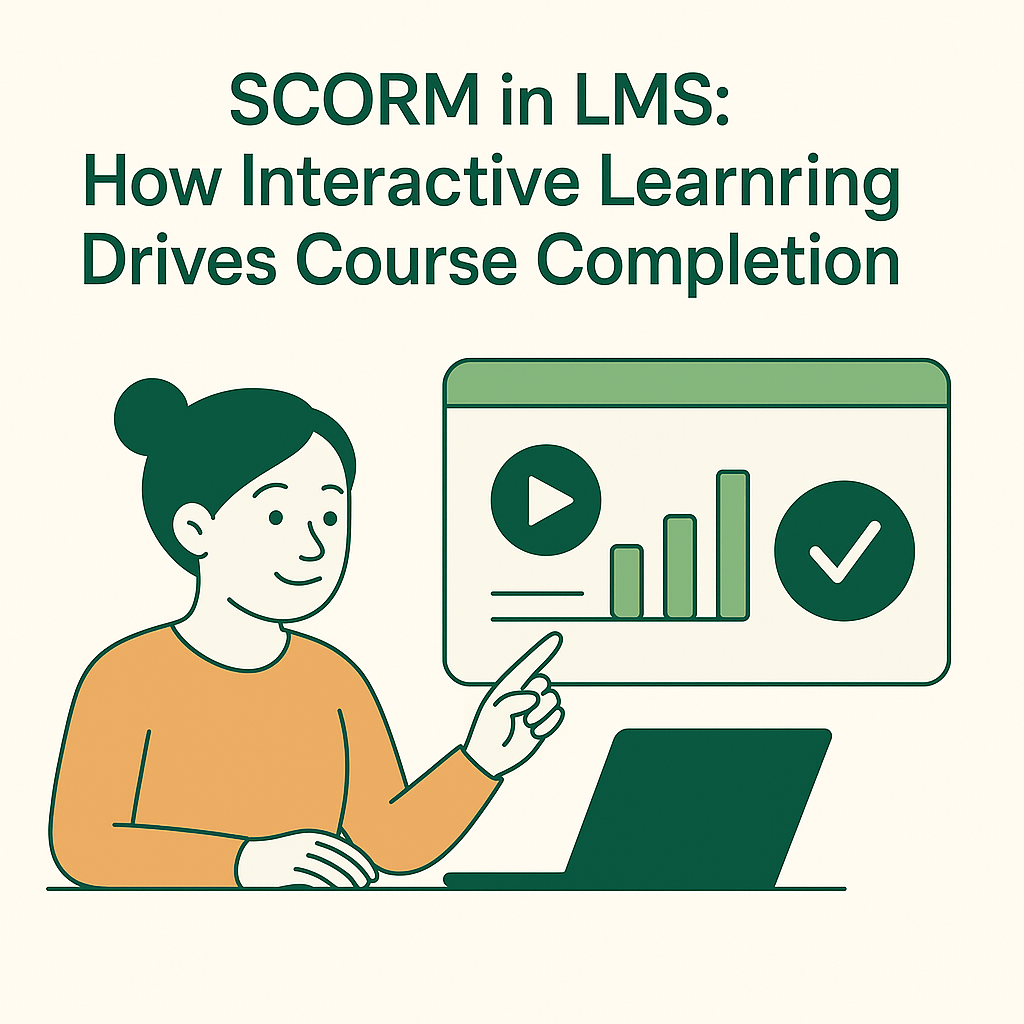SCORM in LMS: How Interactive Learning Drives Course Completion

In the world of corporate training, creating engaging and effective learning experiences is essential to ensure employees stay motivated and complete their courses. One of the key elements behind interactive, engaging learning is SCORM (Sharable Content Object Reference Model), a widely used standard for developing e-learning content. Integrating SCORM in Learning Management Systems (LMS) not only enhances interactivity but also significantly boosts course completion rates.
In this post, we’ll dive into how SCORM works, the benefits of SCORM, and how interactive learning powered by SCORM leads to better outcomes for businesses and learners alike.
What is SCORM?
SCORM is a set of technical standards developed to ensure e-learning content can be created, packaged, and reused across different platforms. In simpler terms, it allows online training content to work seamlessly with any SCORM-compliant LMS. This compatibility ensures that training materials are accessible, trackable, and engaging, no matter where or how learners access them.
SCORM offers features that make it an invaluable tool for interactive learning:
- Content Interoperability: SCORM allows training content to be shared across multiple platforms without compatibility issues.
- Progress Tracking: Learners’ progress can be easily monitored, giving insight into how far they’ve gone in a course and how well they’re performing.
- Modular Design: SCORM-based courses can be broken down into smaller sections, allowing learners to complete the course in manageable chunks.
How SCORM Drives Interactive Learning
One of the most impactful benefits of SCORM is its ability to create interactive learning experiences. Interactive content is crucial to keeping employees engaged and ensuring they complete their training.
Here’s how SCORM enables interactive learning:
1. Interactive Assessments
SCORM allows the integration of quizzes, assessments, and simulations into e-learning courses. These elements not only test knowledge but also keep learners actively engaged. For example, employees can participate in role-playing simulations or complete quizzes that provide instant feedback, reinforcing what they’ve learned.
2. Multimedia Content
SCORM supports a variety of multimedia formats, including videos, animations, and graphics, to create visually appealing and dynamic courses. Instead of reading through static text, learners can watch videos, explore interactive infographics, or engage with animations that explain complex concepts.
3. Branching Scenarios
SCORM-based courses can offer branching scenarios, where learners make decisions that lead them down different learning paths. This interactive approach allows learners to practice real-world decision-making skills and see the consequences of their choices in a safe environment. Branching scenarios keep learners engaged by providing a more immersive and personalized experience.
4. Drag-and-Drop Interactions
SCORM enables drag-and-drop activities, which make learning more tactile and engaging. For example, employees may drag answers into correct slots or sequence steps in a process, reinforcing their understanding through hands-on learning.
The Impact of Interactive Learning on Course Completion
Interactive learning is proven to drive higher engagement and, in turn, better course completion rates. Here’s how SCORM’s interactive features contribute to increased completion:
1. Enhanced Engagement
Static, text-heavy courses can quickly lead to disengagement. SCORM’s ability to integrate multimedia, quizzes, and hands-on activities helps keep learners focused and involved. The more interactive and engaging the course, the more likely employees are to complete it.
2. Active Participation
Learners are more likely to complete a course when they feel involved in the learning process. SCORM’s interactive features—such as quizzes, simulations, and branching scenarios—encourage active participation, making learners feel more invested in their progress. This active participation keeps learners motivated to reach the end.
3. Better Knowledge Retention
Interactive elements, such as quizzes and simulations, help reinforce learning, making it easier for employees to retain information. When learners feel confident in their understanding of the material, they are more likely to complete the course. SCORM’s ability to present information in different formats (text, video, interactive activities) caters to various learning styles, improving knowledge retention across the board.
4. Progress Tracking and Motivation
SCORM enables progress tracking, allowing both learners and administrators to monitor how far employees have come in their courses. Visible progress can be a strong motivator—when learners see how much they’ve already completed, they’re more likely to finish the course. Additionally, administrators can use this data to identify learners who may need extra encouragement or support to complete their training.
The Business Benefits of SCORM-Based Interactive Learning
For organizations, integrating SCORM into their LMS goes beyond improving course completion rates—it has significant business benefits:
1. Higher Employee Engagement
Engaged employees are more likely to complete training, stay with the company, and apply new skills on the job. SCORM’s interactive features make learning more engaging, which leads to higher course completion rates and improved performance.

2. Improved Performance and Productivity
When employees actively participate in their learning and retain information better, they are more likely to apply new skills and knowledge in the workplace. This leads to higher productivity and better job performance, which directly benefits the business.
3. Efficient Training Delivery
SCORM-based courses are modular and easy to update. Companies can quickly modify training content, ensuring that employees are always learning the most up-to-date information. This efficiency leads to cost savings in training development and delivery.
4. Data-Driven Insights
With SCORM’s progress tracking and reporting features, companies gain valuable insights into how employees are performing in their courses. These insights allow organizations to continuously refine and optimize their training programs to ensure maximum effectiveness.
Conclusion
SCORM is a game-changer when it comes to creating interactive learning experiences that boost course completion rates and engagement. By integrating SCORM into your LMS, you can deliver dynamic, engaging, and impactful training that keeps employees motivated and drives better business outcomes.
If your organization is looking to enhance its e-learning programs, consider adopting SCORM-based courses through a powerful LMS like Acadle. By doing so, you’ll not only improve engagement but also ensure that your employees are equipped with the skills and knowledge they need to succeed.